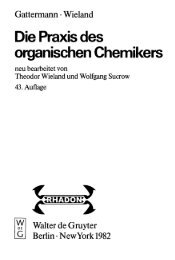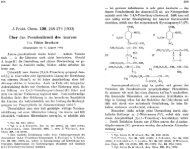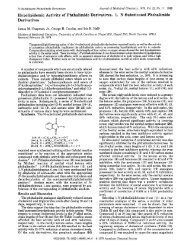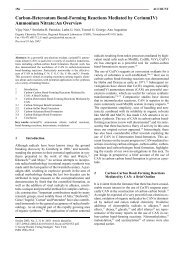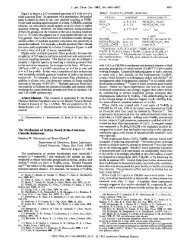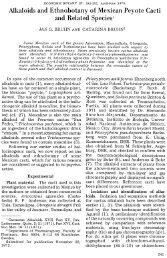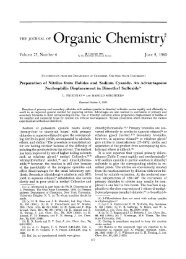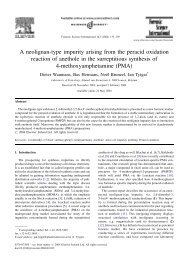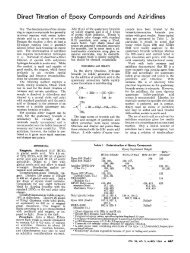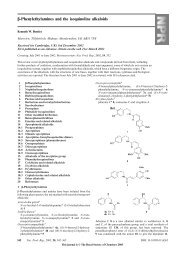Create successful ePaper yourself
Turn your PDF publications into a flip-book with our unique Google optimized e-Paper software.
Alcohol Oxidations Mediated by N-Oxoammonium Salts<br />
23 and 24).<br />
Sodium bromite (Na13r02)20 is intermediate in oxidation<br />
state between sodium hypobromite (NaOBr) and sodium<br />
bromate (Na13r03), the latter of which is not useful for the<br />
present purpose as a cooxidant. An aqueous solution of<br />
NaBr02 at pH 6-8 is proposed to be trimeric, and due to<br />
self-decomposition property at this pH region, the reactivity<br />
as an oxidant is mild, in contrast to that under<br />
acidic conditions.21i22 Such a characteristic nature of<br />
sodium bromite, being specifically effective as an oxidant<br />
for the conversion of N-oxy1 1 to N-oxoammonium salts<br />
2, is adequate for a selective oxidation of alcohols under<br />
mild conditions without loss of the catalyst activity.<br />
Furthermore, as far as NaBr02 is employed as a cooxidant,<br />
the operation described here is quite safe since the reaction<br />
proceeds at a moderate rate (Figure l), and NaBr02 in<br />
basic media liberates no molecular bromine.21<br />
Experimental Section<br />
General Procedures.B Sodium bromite (NaBr02.3H20, 65%<br />
pure as NaBrO,, Kanto Kagaku, Japan) and calcium hypochlorite<br />
(60% pure, Santoku <strong>Chem</strong>ical, Japan) were used as received.<br />
2,2,6,6-Tetramethylpiperidine-l-oxyls (la-d) were prepared from<br />
the corresponding 2,2,6,64etramethylpiperidine according to the<br />
method reportedz4 and purified by recrystallizations or column<br />
chromatography. Starting alcohols were purified by distillation<br />
or column chromatography (SiO,) prior to use.<br />
Oxidation of Primary Alcohols to Aldehydes. Typical<br />
Procedure. Undecanol (3a, 1.72 g, 10 mmol) and 4-(benzoyloxy)-2,2,6,6-tetramethylpiperidine-l-oxyl<br />
(la, 28 mg, 0.1 mmol)<br />
were dissolved in CH2C12 (50 mL) and combined with aqueous<br />
5% NaHC0, (100 mL). On cooling to 0-5 "C, NaBrOz-3H20 (6.2<br />
g, 30 mmol) was added to the above mixture with moderate<br />
stirring. Stirring was continued for an additional 3 h at room<br />
temperature, and ethanol (5 drops) was added. The organic layer<br />
was separated, and the aqueous layer was extracted with CH2Cl2<br />
Combined extracts were washed with brine, dried (Na2S0,), and<br />
concentrated. Flash chromatography of the residue on silica gel<br />
(hexane-AcOEt 1O:l) gave 1.58 g (93%) of undecanal(4a) as an<br />
oil: bp 113 "C (9 mmHg); IR (neat) 2716,1729 (M), 1466 cm-';<br />
'H NMR (500 MHz) 6 0.88 (t, J = 7.0 Hz, 3, CH3), 1.26 (br s, 14,<br />
CH,), 1.62 (m, 2, CH,), 2.41 (dt, J = 7.3, 2.0 Hz, 2, CH,CO), 9.76<br />
(t, J = 2.0 Hz, 1, CHO); 13C NMR (126 MHz) 6 14.1, 22.1, 22.7,<br />
19.2, 29.29, 29.34, 29.4, 29.5, 31.9, 43.9, 203.0.<br />
Oxidation of Primary Alcohol to the Carboxylic Acid. The<br />
alcohol 3a (1.72 g, 10 mmol) and la (28 mg, 0.1 mmol) were<br />
dissolved in MeCN (100 mL) and mixed with aqueous 5%<br />
NaHC03 (100 mL). To this homogeneous solution was added<br />
portionwise NaBr02-3Hz0 (8.30 g, 40 mmol) at 0-5 "C, and the<br />
mixture was stirred vigorously for an additional 3 h at room<br />
temperature. The mixture was acidified with 10% tartaric acid<br />
and taken up in AcOEt (50 mL X 3). Extracts were washed with<br />
brine, dried (Na2S04), and concentrated under vacuum. Chro-<br />
(20) Crystalline NaBrO, is stable in the dark and undergoes dispro-<br />
portionation on heating.,l Aqueous NaBrO, solution is shown to be<br />
trimeric at pH 6-8.,*<br />
3NaBr0, - 2NaBr03 + NaBr (at 109 "C)<br />
2NaBrOB - 2NaBr + 30, (at 359 "C)<br />
'Br /-Na<br />
0-Na<br />
'-Br' -Na<br />
'*Br'<br />
'0-<br />
(21) Kageyama, T. J. <strong>Chem</strong>. SOC. Jpn. 1972, 1064.<br />
(22) Techinical Bulletin on sodium bromite from Nippon Silica Industrial<br />
Co., 1984.<br />
(23) All reactions were carried out under an argon atmosphere.<br />
Melting points and boiling points indicated by an air-bath temperature<br />
are uncorrected. GC analyses were carried out on a Yanagimoto Model<br />
G6800 with a Quadrex bond-fused silica capillary column (methylsilicone:<br />
0.25-rm film thickness, 25 m X 0.25-m i.d.). 'H NMR and 13C NMR<br />
spectra were recorded in CDC1,.<br />
(24) Rozantsev, E. G.; Neiman, M. B. Tetrahedron 1964, 20, 131.<br />
J. <strong>Org</strong>. <strong>Chem</strong>., Vol. 55, No. 2, 1990 465<br />
matographic purification (hexane-AcOEt 1:l) of the crude<br />
products gave 1.71 g (92%) of undecanoic acid (5a): mp 28 OC;<br />
IR (KBr) 3500-2500 (COOH), 1698 (C=O), 1468,1435,1412,1290,<br />
932 cm-'; 'H NMR (60 MHz) 6 0.87 (t, 3, CH,), 1.25 (br s, 16, CHd,<br />
2.31 (t, J = 6.7 Hz, 2, CH,CO), 11.37 (br s, 1, COOH).<br />
Oxidation of Primary Alcohol to the Dimeric Ester. To<br />
a solution of 3a (172 mg, 1 mmol) in AcOH (0.2 mL) was added<br />
aqueous NaBrOz.3H20 (622 mg, 3 mmol) in H20 (1 mL) at room<br />
temperature over 30 min. After stirring for 12 h, the mixture was<br />
neutralized with aqueous NaHCO, and extracted with CH,Cl,.<br />
Extracts were washed with brine, dried (Na2S04), and concentrated.<br />
Chromatographic purification (hexane-AcOEt 15:l) of<br />
the crude products gave 158 mg (92%) of undecanyl undecanoate<br />
(6a) as an oil: IR (neat) 1742 (COO), 1466,1379,1241,1170,1114<br />
cm-'; 'H NMR (500 MHz) 6 0.88 (t, J = 7.5 Hz, 6, CH,), 1.26 (br<br />
s, 30, CH,), 1.61 (m, 4, CH,), 2.28 (t, J = 7.5 Hz, 2, CH,), 4.05<br />
(t, J = 6.5 Hz, 2, CH,O).<br />
Oxidation of Secondary Alcohols to the Ketones. Typical<br />
Procedure. A solution of 4-tert-butylcyclohexanol (7.81 g, 50<br />
mmol) and 4-(benzoyloxy)-2,2,6,6-tetramethylpiperidine-l-oxy~<br />
(la, 138 mg, 0.5 mmol) in CH2C12 (100 mL) was combined with<br />
aqueous 5% NaHC03 (100 mL). To this biphase mixture was<br />
added portionwise NaBr02.3H20 (31.2 g, 150 "01) with vigorous<br />
stirring and cooling in an ice bath. Stirring was continued for<br />
an additional 3 h at room temperature, and the reaction was<br />
quenched with aqueous 5% sodium bisulfate (3 mL). The mixture<br />
was worked up in the usual manner, and the crude products were<br />
distilled to give 6.86 g (89%) of 4-tert-butylcyclohexanone: mp<br />
48-49 "C (from hexane).<br />
Oxidation of l,4-Dihydroxyl Compounds to the y-Lactones.<br />
Typical Procedure. l&Decanediol (174 mg, 1.0 mmol)<br />
and la (2.8 mg, 0.01 mmol) were dissolved in CH2Clz (5 mL) and<br />
combined with aqueous 5% NaHC0, (10 mL). To this two-phase<br />
solution was added NaBrO2-3H20 (832 mg, 4 mmol) with vigorous<br />
stirring and cooling with an ice bath. Stirring was continued for<br />
an additional 3 h at room temperature. The organic layer was<br />
separated, and the aqueous layer was extracted with CH2C12.<br />
Combined extracts were washed with 5% sodium bisulfate, dried<br />
(Na2S04), and concentrated. Chromatographic purification of<br />
the crude products gave 168 mg (99%) of decan-4-olide: bp<br />
136-138 "C (9 mmHg) (lit.% bp 84 "C (0.2 mmHg)); IR (neat) 1770<br />
(C=O), 1465, 1170,900 cm-'; 'H NMR (200 MHz) 6 0.88 (t, J =<br />
6.6 Hz, 3, CH3), 1.29 (m, 6, CH,), 1.4-1.80 (m, 4, CH,), 1.80-1.98<br />
(m, 2, CH,), 2.32-2.68 (m, 2, CH,CO), 4.20-4.35 (m, 1, CHO);13C<br />
NMR (50 MHz) 6 14.6, 19.1, 23.1, 25.2, 28.4, 30.1, 32.2, 36.4, 81.2,<br />
172.6.<br />
Oxidation of 1,3-Diols to the Corresponding Aldols. A<br />
solution of 2-ethyl-1,3-hexanediol (4.39 g, 30 mmol; 1.3-1.4:1<br />
stereoisomers on 'Y! NMR) in CH2CI2 (50 mL) was combined with<br />
aqueous 5% NaHC0, (100 mL) and cooled to 0-5 "C. To this<br />
two-layer solution was added la (83 mg, 0.3 mmol) and then<br />
NaBrOz.3H,0 (18.7 g, 90 mmol) with moderate stirring. After<br />
this stirred for an additional 3 h at room temperature, ethanol<br />
(5 drops) was added. The organic layer was separated, and the<br />
aqueous layer was extracted with CH2Cl2 Combined extracts were<br />
washed with brine, dried (Na2S04), and concentrated to give 4.14<br />
g (96%) of 2-ethyl-3-hydroxyhexanal(1.3-1.4:1 stereoisomers on<br />
13C NMR): bp 101 "C (9 mmHg) (lit.26 bp 107-110 "C (16<br />
mmHg)); IR (neat) 3330 (OH), 2734, 1721 (C=O), 1464, 1381,<br />
1149, 1125, 977 cm-'; 'H NMR (500 MHz) 6 0.94, 0.95, 0.99 (t,<br />
J = 8 Hz, 6, CH3), 1.30-1.58 (m, 4, CH2), 1.62-1.84 (m, 4, CH,),<br />
1.94, 2.13 (br, 1, OH), 2.26, 2.31 (m, 1, CHCO), 3.88, 3.98 (m, 1,<br />
CHO), 9.75, 9.77 (d, J = 3, 2 Hz, 1, CHO); 13C NMR (126 MHz)<br />
6 11.5, 12.2, 13.83, 13.85, 17.5, 18.7, 19.1, 19.4, 36.5, 37.1, 58.61,<br />
58.70, 70.5, 70.8, 205.6, 205.9.<br />
(2R,3R)-2-Benzyl-3-hydroxybutanal(93:7 stereoisomers on 13C<br />
NMR) was obtained in 94% yield by the similar oxidation of<br />
(2S,3R)-2-benzyl-1,3-butanediol(955 stereoisomers on lSC NMR)<br />
as above at 0 "C. The starting diol was prepared by reduction<br />
of ethyl (2R,3R)-2-benzyl-3-hydroxybutanoate with LiAlH,.,'<br />
Spectral data of the crude aldol:19 IR (neat) 3332 (OH), 2735,<br />
(25) Kharasch, M. S.; Skell, P. S.; Fisher, P. J. Am. <strong>Chem</strong>. soc.1948,<br />
70, 1055.<br />
(26) Blanc, P. Y.; Perret, A,; Teppa. F. Helu. Chim. Acta 1964,47,567.<br />
(27) Frater, G. Helu. Chim. Acta 1979, 62, 2825.




